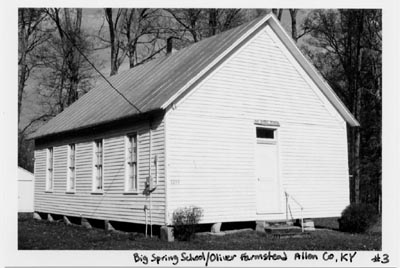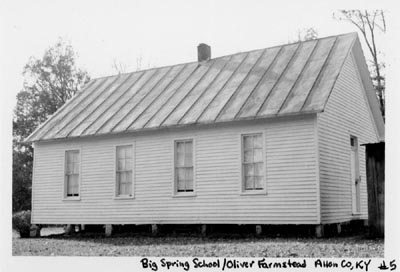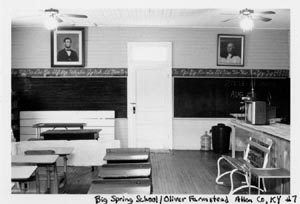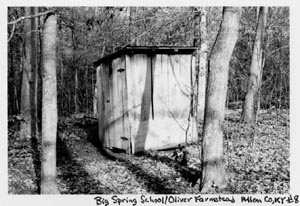|
[1]
Retired Teachers of Allen County, School Days of
Allen County, Kentucky:
From Ciphering and Reciting to the Age of Technology. (Allen
County,
Kentucky: privately printed, 1992), 17.
[2]
Quoted in Edwina Ann Doyle, Ruby Layson, and Anne Armstrong, eds, From the
Fort to the Future: Educating the Children of
Kentucky.
(Kentucky Images: Lexington, Kentucky, 1987), 108.
[3]
Rachel Kennedy and Cynthia Johnson, Kentucky Historic Schools Survey: An
Examination of the History and Condition of Kentucky’s Older School
Buildings.
(Frankfort, Kentucky: Kentucky Education, Arts, and Humanities Cabinet,
2002), 34-35.
[4]
Retired Teachers, School Days of Allen County, viii.
[5]
Doyle, Layson, and Armstrong, From the Fort, 112.
[6]
Quoted in Retired Teachers, School Days of Allen County, viii.
[7]
Charles E. Martin, The Pennyrile Cultural Landscape. (United States
Department of the Interior, National Park Service and Kentucky Heritage
Council, 1988), 468.
[8]
Allen County, Kentucky, Deed book 4, p.6; Retired Teachers, School Days of
Allen County, Kentucky, 17.
[9]
Wilmer Dean Oliver, telephone interview by author, 18 November, 2002,
notes in author’s possession.
[10]
C.W. Hackensmith, “Out of Time and Tide: the Evolution of Education in
Kentucky,” Bulletin of the Bureau of School Service XLIII, no. 2 (Dec
1970): 89.
[11]
Dal Clark, interview by author, 8 September, 2002, vicinity of Settle,
Kentucky, notes in author’s possession.
[12]
U.S. Department of Commerce and Labor, Bureau of the Census, Twelfth
Census of the United States: 1900, Population Schedule, Commonwealth of
Kentucky, Allen County, Supervisor’s District 3, Enumeration District 5,
Sheet 3.
[13]
Printed in Retired Teachers, School Days of
Allen County,
179.
[14]
U.S. Department of Commerce and Labor, Bureau of the Census, Thirteenth
Census of the United States: 1910, Population Schedule, Commonwealth of
Kentucky, Allen County, Supervisor’s District 3, Enumeration District 6,
Sheet 10A.
[15]
U.S. Department of Commerce and Labor, Bureau of the Census, Twelfth
Census
of the United States:
1900.
[16]
Martin, The
Pennyrile Cultural Landscape, 520.
[17]
U.S. Department of Commerce and Labor, Bureau of the Census, Twelfth
Census
of the United States:
1900;
Thirteenth Census of the
United States: 1910.
[18]
Martin, The Pennyrile Cultural Landscape, 495-496.
[19]
Wilmer Dean Oliver, electronic mail messages to author, 31 May and 2 June,
2003; U.S. Department of Commerce and Labor, Bureau of the Census,
Fifteenth Census of the United States: 1930 Population Schedule,
Commonwealth of Kentucky, Allen County, Supervisor’s District 11,
Enumeration District 2-7, Sheet 4A.
[20]
Allen County, Kentucky, County School Census, Subdistrict 12, 1924; Allen
County, Kentucky, Enumerating Sheet for Recording School Census Data,
Subdistrict 12, 1934.
[21]
Noble Allen, Superintendent of Allen County Schools, open letter, 13
September, 1958.
[22]
Martin, The Pennyrile Cultural Landscape, 492.
[23]
Martin, The Pennyrile Cultural Landscape, 4, 6.
[24]
Kennedy and Johnson, Kentucky Historic Schools Survey,
28.
|




